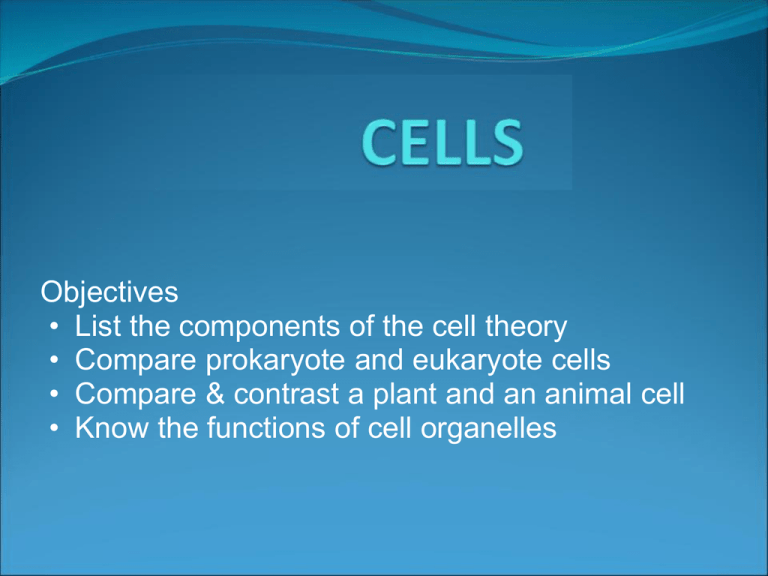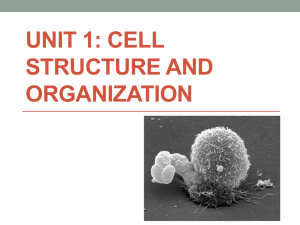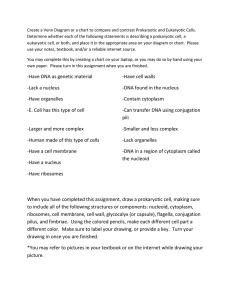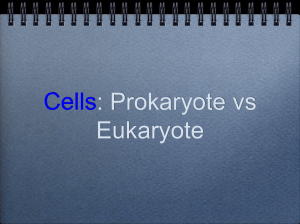Cell Notes
advertisement

Objectives • List the components of the cell theory • Compare prokaryote and eukaryote cells • Compare & contrast a plant and an animal cell • Know the functions of cell organelles Early Contributions • Anton van Leeuwenhoek – • Made 1st microscope • Observed living cells called "animalcules“ • Robert Hooke • Observed tiny units in cork and named them “cells” • Theodore Schwann - zoologist who observed tissues of animals had cells (1839) • Mattias Schleiden - botanist, observed tissues of plants contained cells ( 1845) The Cell Theory 1. All organisms are composed of one or more cells 2. The cell is the basic unit of structure and functions of living things 3. All cells come from pre-existing cells The cell is the Basic Unit of Life • Cell is basic unit of life • Unicellular organisms are made of one cell only • The cells of multicellular organisms are specialized to perform different functions Levels of Organization CELLS (muscle cells, nerve cells) TISSUES ORGANS (muscle, epithelium) (heart, lungs, stomach) SYSTEMS ORGANISM (circulatory system) (human) Common Cell Features ALL CELLS have these parts: • Ribosomes – make protein for use by the organism (protein synthesis) • Cytoplasm – fluid material within cell; carbohydrate and water based solution that suspends all internal parts of the cell • DNA – genetic blueprint; is a nucleic acid • Cell Membrane – outer boundary of cells, determines what goes in and out , semipermeable, made up of a phospholipid bilayer Two Types of Cells: Prokaryote and Eukaryotes Prokaryote Cells • • • • • • • • • The first cells to inhabit the earth Smallest and simplest cells Always a single–celled organism Bacteria These cells do NOT have a nucleus No membrane-bound organelles DNA is circular and floats in the cytoplasm Have a cell wall Many have flagella – long, threadlike structures that protrude from the cell’s surface and enable movement (whip-like tail) A capsule surrounds some bacteria and helps them avoid the body’s immune system and cling to almost anything (teeth, skin, and food) Prokaryotic Cell Bacteria Images Bacteria that causes Anthrax Eukaryotic Cells • Cells found in plants, animals, protists, and fungi • Have a Nucleus • Have membrane-bound organelles • Larger cells than prokaryotes • More complex • DNA is linear • Evolved from prokaryotes Eukaryotic Cell Animal Cell • 1. cell (plasma) membrane – thin, transparent, 2-layered, semi-permeable (porous), flexible -controls what enters and leaves cell -separates cell from its environment 2. nucleus – command center of the cell; most cells have only one; some have >1 DNA: (one of two forms) a) chromatin – mass of thread-like fibers scattered through the nucleus (normal) b) chromosomes – compact chromatin (when dividing) -direct & store instructions for all cell functions and control inheritance of traits c) nuclear membrane – 2-layered, semi-permeable, porous, surrounds nucleus d) nucleolus – cell may have 1 or 2; produce granules rich in RNA, each granule will become part of a ribosome e) nucleoplasm - fluid within the nucleus * 3. cytoplasm – jelly-like fluid outside nucleus, but within cell -transports chemical substances within the cell 4. endoplasmic reticulum – network of interconnected membranes (ER) -storage, separation, and transport of substances made within the cell (mostly proteins) a) rough ER – dotted with ribosomes b) smooth ER – no ribosomes 5. Golgi apparatus (body) – stack of flattened membranes where proteins are packaged and distributed 6. vacuole – clear, fluid-filled sac; used for storage 7. lysosome – small sac filled with powerful chemicals which break down food molecules and digest old organelles; surrounded by a membrane 8. mitochondria – “powerhouse” of the cell; bean-shaped; one of the largest and most numerous; site of cellular respiration Cytoskeleton 9. microtubules – long, thin, hollow cylinders; in cytoplasm, they support cell (shape) or are arranged in bundles in other structures (like cilia, flagella, or centrioles* - only in animal cells) 10. microfilaments – tiny-threadlike fibers made of protein; contract like muscle cells for movement 11. ribosomes – tiny, round bodies involved in protein synthesis from amino acids Plant Cell -have a cell wall composed of cellulose (provides structure and support) -contain chloroplasts – function in photosynthesis (football shaped), starch granules – spherical, function in food storage, and carotens – contain orange pigments; spherical -plant cells are rectangular in shape (animal cells are spherical) -have a large water vacuole which provides turgor pressure










